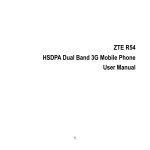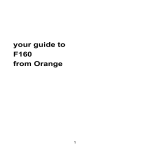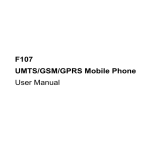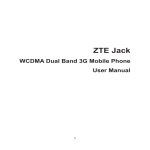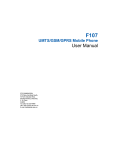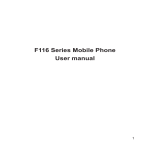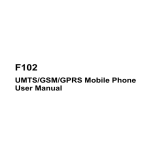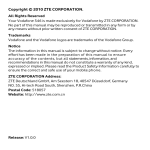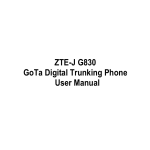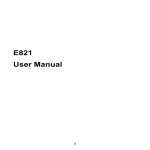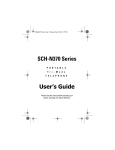Download F116 User Manual
Transcript
F116 User Manual LEGAL INFORMATION Copyright © 2012 ZTE CORPORATION. All rights reserved. No part of this publication may be excerpted, reproduced, translated or utilized in any form or by any means, electronic or mechanical, including photocopying and microfilm, without the prior written permission of ZTE Corporation. The manual is published by ZTE Corporation. We reserve the right to make modifications on print errors or update specifications without prior notice. Version No. : R1.0 Edition Time : 201206 Manual No. : 079584504670 Contents For Your Safety..........................................................8 General Care.................................................................... 8 Aircraft Safety................................................................. 10 Hospital Safety................................................................11 General Guidelines..........................................................11 Road Safety.................................................................... 12 Vehicles Equipped with an Airbag.................................. 13 Third Party Equipment.................................................... 14 Radio Frequency (RF) Energy....................................... 14 Emergency Services...................................................... 15 Information on Privacy.................................................... 16 Copyright Notice............................................................. 16 Getting Started.........................................................17 Your F116....................................................................... 17 Technical Parameters..................................................... 19 Starting Up..................................................................... 19 Battery....................................................................... 19 Installing and Removing the (U)SIM Card................. 22 Inserting and Removing the microSD Card............... 23 Powering On/Off........................................................ 23 Indicators........................................................................ 24 Standby Mode................................................................ 25 Entering Text.................................................................. 25 Input Modes.............................................................. 25 Word Predictive Text Mode....................................... 26 Alphabetic Modes...................................................... 26 Numeric Mode........................................................... 26 Symbols.................................................................... 27 Basic Operations............................................................ 27 Menu Navigation....................................................... 27 Shortcuts in Standby Mode....................................... 28 Keypad Lock............................................................. 28 Using the Phone......................................................29 Making a Call.................................................................. 29 Making a Voice Call................................................... 29 International Call....................................................... 29 Calling an Extension................................................. 29 Making a Call from Contacts..................................... 29 Making a Call from Call Log...................................... 30 Making a Call from Messages................................... 30 Making a Speed Dial Call.......................................... 30 Answering a Call............................................................ 31 In-call Options................................................................ 31 Call History..................................................................... 32 Using (U)SIM Card Services (STK)................................ 32 Messaging................................................................33 Composing and Sending a Message............................. 33 Composing and Sending an E-mail................................ 34 Deleting Messages/E-mails............................................ 34 Moving and Copying Messages..................................... 35 Configuring Message Settings....................................... 35 Mul. Msg. Settings..................................................... 35 Text Msg. Settings..................................................... 36 Templates Setting...................................................... 36 Configuring E-mail Settings............................................ 36 Mailbox Settings........................................................ 36 Automatic Retrieval................................................... 37 Templates Setting...................................................... 37 Personal Information...............................................38 Contacts......................................................................... 38 Creating a Contact.................................................... 38 Deleting a Contact..................................................... 38 Groups...................................................................... 38 Other Options............................................................ 39 Calendar......................................................................... 39 Adding New Events................................................... 39 Viewing and Editing Events....................................... 40 Sending Events......................................................... 40 Deleting Events......................................................... 40 Calendar Settings...................................................... 40 Experiencing Multimedia........................................41 Camera and Video Camera............................................ 41 Capturing a Photo or Recording a Video Clip........... 41 Setting the Cameras................................................. 41 FM Radio........................................................................ 42 Media Play...................................................................... 42 Playing audios and videos........................................ 43 Using the Playlist....................................................... 43 Voice Recorder............................................................... 43 Adding a Record....................................................... 43 Playing a Record....................................................... 44 Streaming URL............................................................... 44 Getting Connected..................................................45 Connecting to the Internet.............................................. 45 Network Access Point and Connections................... 45 Web Browser.................................................................. 46 Setting the Browser................................................... 46 Linking to a Web Page.............................................. 46 Web Page Options.................................................... 47 Setting up Your Phone............................................48 Screen Settings.............................................................. 48 Handset Settings............................................................ 48 Profiles........................................................................... 49 Security Settings............................................................ 50 Call Settings................................................................... 51 Other Functions.......................................................52 Managing Files............................................................... 52 Setting Alarms................................................................ 52 Stopwatch....................................................................... 52 World Time..................................................................... 53 Calculator....................................................................... 53 Converting Currencies.................................................... 53 Games & Applications.................................................... 54 Questions & Answers.............................................55 Declaration of RoHS Compliance..........................61 Disposal of Your Old Appliance.............................62 For Your Safety General Care Your handset contains delicate electronic circuitry, magnets and battery systems. You should treat it with care and give particular attention to the following points: • Do not allow the handset, battery or accessories to come into contact with liquids or moisture at any time. Do not immerse the handset in any liquid. • Do not place the handset alongside computer disks, credit cards, travel cards and other magnetic media. The information contained on disks or cards may be affected by the handset. • Do not paint the handset. • Do not leave the handset or the battery in places where the temperature could exceed 60°C, e.g. on a car dashboard or a windowsill, behind glass in direct sunlight, etc. • Do not remove the handset’s battery while the handset is switched on. • Take care not to allow metal objects, such as coins or key rings to contact or short-circuit the battery terminals. • Do not dispose of battery in a fire. The handset’s Li-ION batteries may be safely disposed of at a Li-ION recycling point. Follow local requirements for recycling. • Do not put the handset’s battery in your mouth, as battery electrolytes may be poisonous if swallowed. • Do not attempt to dismantle the handset or any of its accessories. • Do not put a battery into a microwave oven, dryer, or high-pressure container. • Do not contact battery directly to an electric outlet or cigarette lighter charger. Use only approved charger units. • Do not pierce battery with a sharp object such as a needle. • Do not disassemble or modify the battery. • Do not use a damaged or deformed battery. • Do not drop, throw, or subject the handset to rough treatment. • Do not solder the battery directly. • S t o p u s i n g t h e b a t t e r y i f a b n o r m a l h e a t , o d o r, discoloration, deformation, or abnormal condition is detected during use, charge, or storage. • Remove the battery whose life cycle has expired from equipment immediately. • This equipment is fitted with an internal battery. Take it to a qualified service engineer when the replacement of the battery is required. • The earpiece may become warm during normal use. Also, the handset itself may become warm while the battery is being charged. • When a handset is in vibration mode, the vibration can sometimes cause the handset to move. • Be careful not to place the handset near heat sources (such as a heater) or too close to the edge of the table. • Power off your phone before you clean it. Use a damp or anti-static cloth to clean the handset. Do not use an ordinary dry cloth or electrostatic cloth. Do not use chemical or abrasive cleaners as these could damage the casing. • Remember to make backup copies of all important data on your handset. • Remember to recycle: the cardboard packing supplied with this handset is ideal for recycling. Warning: In the unlikely event of a battery leak, take care to keep the battery discharge away from your eyes or skin. If the leakage does come into contact with the eyes or skin, please flush thoroughly in clean water and consult with a doctor. Aircraft Safety • Power off your phone before the airplane takes off. In order to protect airplane’s communication system from interference, it is prohibited to use mobile phone in flight. If you want to use mobile phone before the airplane takes off, you should get aircrew’s permission according to safety regulations. • If the mobile phone has the function of automatic timing power-on, please check your alarm setting to ensure that 10 your phone will not be automatically powered on during the flight. Hospital Safety • Power off your phone and remove the battery in areas where the use of handsets is prohibited. • Follow the instructions given by the respective medical facility regarding the use of handsets on their premises. General Guidelines • In some countries, national law prohibits private copying of copyrighted material. Please check the national legislation of the applicable country concerning the use of such material. • Many jurisdictions have laws and regulations about taking pictures in public or private areas and regarding the processing and further use of such pictures. The manufacturer encourages its customers to obey all laws and to respect the personal rights of others. • Please check roaming agreement availability with your service provider. • The use of mobile phones is not allowed in some radiation sensitive areas, such as hospitals, research centers and airplanes. The user is responsible to power-off the device. If there is any uncertainty, you should remove the battery from the handset. 11 • Observe any signs that indicate powering off handsets, such as those near gas stations, or explosives, and power off the handset/device immediately. • If you have a heart condition, be careful with the settings of call vibration or tone volume. • Do not allow children to play with the handset, charger or batteries. • Do not use the handset where blasting is in progress. • Do not try to make a call or conversation while the temperature of charging battery is above 50°C. • Take care not to put your handset in the back pocket of your trousers or skirt and then sit on it. Also, do not put your phone at the bottom of bag where it may subject to excessive weight or pressure. Doing so may damage the LCD and camera lens and cause them malfunction. • The operation of some medical electronic devices, such as hearing aids and pacemakers, may be affected if a handset is used next to them. Observe any caution signs and the manufacturer’s recommendations. • Do not leave the handset discharged or without a battery for a long time, otherwise some data may be erased. • Your phone contains metal, which may cause you an itch, a rash or eczema depending on your physical condition. Road Safety • You must exercise proper control of your vehicle at all times. Give your full attention to driving. 12 • Observe all of the recommendations contained in your local traffic safety documentation. • Pull off the road and park before making or answering a call, if driving conditions require so. Check if local laws and/or regulations restrict the use of handsets while driving. • You MUST NOT stop on the hard shoulder of a motorway to answer or make a call, except in an emergency. • Power off your handset at a refueling point, such as a gas station, even if you are not refueling your own car. • Do not store or carry flammable or explosive materials in the same compartment as the handset. • Electronic systems in vehicle, such as anti-lock brakes, speed control and fuel injection systems are not normally affected by radio transmissions. The manufacturer of such equipment can advise if it is adequately shielded from radio transmissions. If you suspect vehicle problems caused by radio transmissions, consult your dealer and do not power on the handset until it has been checked by a qualified technician. Vehicles Equipped with an Airbag An airbag inflates with great force. Do not place objects, including either installed or portable wireless equipment, in the area over the airbag or in the airbag deployment area. If in-vehicle wireless equipment is improperly installed and the airbag inflates, serious injury could result. 13 Third Party Equipment The use of third party equipment, cables or accessories, not made or authorized by ZTE, may invalidate the warranty of your handset and also adversely affect the phone’s safety/ operation. Radio Frequency (RF) Energy Your handset is a low-power radio transmitter and receiver. When powered on, it intermittently receives and transmits radio frequency (RF) energy (radio waves). The transmit power level is optimized for the best performance, and automatically reduces in the areas with better reception. Exposure to radio frequency energy Radio wave exposure and Specific Absorption Rate (SAR) information: • The handset is designed to comply with safely, requirements for exposure to radio waves. This requirement is based on scientific guidelines that include safety margins designed to assure the safety of all persons, regardless of age and health. • The radio wave exposure guidelines employ a unit of measurement known as the Specific Absorption Rate, or SAR. Tests for SAR are conducted using a standardized method with the phone transmitting at its highest certified power level in all used frequency bands. 14 • While there may be differences between the SAR levels of various network operator phone models, they are all designed to meet the relevant guidelines for exposure to radio waves. • The SAR limit recommended by the International Commission on Non-Ionizing Radiation Protection (ICNIRP), is 2.0 W/kg averaged over ten (10) grams of tissue. • The highest SAR value for this model phone tested for use at the ear is 0.953 W/kg (10g). Emergency Services To make an emergency call in any country: 1. Ensure that your handset is on and in service. 2. Press End Key as many times as needed to clear the display and ready the device for calls. 3. Enter the official emergency number for your present location, for example, 112 (the international emergency number). 4. Press Send Key to dial the number. Follow instructions received and do not end the call until told to do so. When the USIM card is not inserted, press Right Soft Key [SOS] and then enter the official emergency number for your present location. Press Send Key or OK Key [Call] to dial the number. If the keypad lock is on, enter the emergency number directly and press Send Key. 15 Notes: • Tell the operator which service you require: Police, Ambulance, Fire Brigade, Coastguard or Mountain Rescue Service. Tell them where you are and remain stationary to maintain contact if possible. • Due to the nature of the cellular system, the connection of emergency calls cannot be guaranteed. You should never rely solely on any wireless device for essential communications like medical emergencies. Information on Privacy Camera usage and photo/audio/video recordings carried out with the handset can offend the confidentiality of the subjects. The user therefore is held to respect legislation in confidentiality matter and remains the only responsible subject in case of eventual violations of the enforced norm. Copyright Notice The video/audio recordings you make/download are protected by copyright laws. They are for personal use only and must not be otherwise used without the permission of the copyright owner. 16 Getting Started Your F116 The F116 described in this manual is approved for use on the UMTS/GSM/GPRS/EDGE networks and achieves seamless handover between them. Empowered by the 3G technology, F116 converges real-life experiences with real-time connectivity. Enjoy the feature of high-speed, broadband-quality connectivity wherever you go. The F116 supports operations on the PC. You can manage your contacts, messages and files with the software on your computer, or use the phone as a modem for the PC and surf the Internet. When using this device, obey all laws, respect the privacy and legitimate rights of others, including copyrights. 17 18 Technical Parameters Dimensions (L×W×H) 110 mm×47.5 mm×11.8 mm Weight Approx 70 g (including battery) Display 2.0 inches 176*220 TFT Camera 2.0 M pixel camera Battery 820 mAh, Lithium ion (Li-ion) Continuous idle time GSM: 200 hours; WCDMA: 320 hours Continuous talk time GSM: 400 minutes; WCDMA: 240 minutes Charge time Approx 3 to 4 hours * The phone’s talk and standby times are based on ideal working environments. The use of extended backlight, browser, and network conditions can reduce battery life and talk/standby time. Starting Up Battery The lithium ion rechargeable battery of the mobile phone can be immediately used after unpacking. A new battery performs best after performing a full charge/discharge 3 times. When not using the battery for a long period, remove it from the phone and store it in a cool dry place. 19 Installing the Battery 1. Hook the edge of the back cover and lift it up to remove it, as shown in the picture. 2. Insert the battery by aligning the gold contacts on the battery with the gold contacts in the battery compartment on the phone. 3. Push down on the battery until it clicks into place. 4. Replace the back cover. 20 Removing the Battery 1. Make sure that your mobile phone is switched off. 2. Remove the back cover. 3. Pull the battery up and remove it from the mobile phone. Charging the Battery Use the battery up completely before charging the battery for the first time with the procedure indicated below. Caution: Do not charge the battery out of the temperature range of 0°C to 45°C. 1. Connect your adapter to the bottom of your mobile phone as shown in the picture. 2. Connect the other end of the adapter to the mains socket. Remove the charger from both the mains socket and the phone once the charging completed. 21 Installing and Removing the (U)SIM Card 1. Make sure that the phone is switched off and the charger is disconnected from the phone. 2. Turn the phone over and remove the back cover. 3. If the battery is already inside, remove it. 4. Hold your (U)SIM card with the cut corner oriented as shown above the (U)SIM card slot and then slide it into the slot. 5. Replace the battery first. 6. Replace the back cover. Caution: Do not bend, scratch the (U)SIM card, or unnecessarily touch its metal surface. It may damage the information stored. To remove the (U)SIM card, slide it out of the card slot. 22 Inserting and Removing the microSD Card Your phone supports microSD cards with capacity up to 8GB, giving you a very large memory capacity to save images, photos, audio and video files. Notes: microSD logo Association. is a trademark of the SD Card 1. Open the cover of the memory card slot on the left side of the phone. 2. Insert the memory card carefully with the metal contacts facing upwards until it clicks into the right position. To remove the card, press and release the card so it clicks out. Then, remove it carefully from the slot. Powering On/Off 1. Make sure that your SIM card is inserted and the battery is charged. 23 2. Press and hold End Key to power on/off the phone. The phone will automatically search for the network. Notes: You may need to enter the Personal Identification Number (PIN) or phone password if you have enabled PIN lock or phone lock feature. (See Setting up Your Phone — Security Settings.) Indicators Indicator What it means Signal strength Battery status Silent mode Meeting mode Headset inserted Alarm on Bluetooth on 24 New SMS New MMS Missed voice call Standby Mode When you turn on the phone, it enters the standby mode. You can find the following information: • Indicator icons • Network name or the operator logo • Date and time • Functions of Left Soft Key, OK Key and Right Soft Key. You can return to the standby mode from any interface by pressing End Key as many times as needed. Entering Text Input Modes Your mobile phone provides the following input methods: word predictive text mode (EN), lowercase alphabetic mode (abc), uppercase alphabetic mode (ABC) and numeric mode (123). The current input mode is displayed on the screen above the input field. You can press # Key to change the input mode. 25 Word Predictive Text Mode Word predictive text mode is based on a built-in dictionary. It gives word choices for you from the combination of letters you have pressed. • Press only once each key associated with the letter you want to enter. The letters you have entered appear on the display. The candidate words change with each key you press. When the candidate word you need is displayed, press Up Key or Down Key to highlight the word and press OK Key to confirm. • You can also select Spell word? to spell a new word and select Save. The new word will be added to the phone dictionary. • Press 0 Key to insert space. • Press Clear Key to delete letters left of the cursor. Alphabetic Modes Press 2~9 repeatedly until the desired character appears. Press once to input the first letter on the key; press twice quickly to input the second letter, and so on. Press 0 Key to enter a space; press it twice quickly to enter 0. Press Clear Key to delete letters left of the cursor. Numeric Mode In numeric mode, use the alphanumeric keys to enter numbers. Letters and spaces cannot be entered in this mode. 26 Symbols Press * Key to select the symbol you need and press OK Key to insert the selected symbol into the text. In word predictive text mode and alphabetic modes, you can also press 1 Key to enter commonly used symbols. Basic Operations Menu Navigation You can access the phone’s functions through menus and submenus. First press OK Key in standby mode to open the main menu. Scroll up, down, left or right to select an item, and press OK Key to open the item or submenu until you find the item you need. You can also open the items in the main menu by pressing the alphanumeric keys. For instance, press 1 Key to open Tools, 2 Key to open Browser, and 9 Key to open File Manager. In some submenus, there is a number before each menu item. You can press the number on the keypad to open the corresponding item. Notes: In this user manual, the steps needed to reach a menu are shown in a condensed form, for example: Menu > Settings > Phone > Auto keyguard > 10s autokeyguard. 27 Shortcuts in Standby Mode You can press the four Navigation Keys to access functions or menus from standby mode. • Up Key: Access to Calendar. • Down Key: Access to Contacts. • Left Key: Access to Multimedia. • Right Key: Access to Messages. Notes: You can customize the shortcuts in Settings > Phone > Shortcut keys. Keypad Lock You can use the keypad lock to prevent the keys from being accidentally pressed. In standby mode, hold * Key to lock the keypad. To unlock the keypad, press OK Key and then press * Key. 28 Using the Phone Making a Call Making a Voice Call 1. 2. Enter a phone number in standby mode. Press Send Key or OK Key to call. Tips: You can also select Options > Call > Voice call to dial out, select Save to save the number, or select Send Message to send a message. 3. Press End Key to end the call. International Call 1. Press * Key twice to enter “+”. 2. Enter the country code, area code and the phone number. 3. Press Send Key or OK Key to call. Calling an Extension Enter the phone number first and then, before entering the extension number, press * Key three times consecutively to enter “P”. For example, to call 123456 ext. 765, press 123456***765. Making a Call from Contacts 1. In standby mode, press Right Soft Key or select Menu > Contacts. 29 2. Select a contact and then press Send Key or select Options > Call > Voice call. Making a Call from Call Log 1. Press Menu > Recent Call in standby mode to open call history. You can also enter All calls log by pressing Send Key from standby mode. 2. Select a call type and the number you need. 3. Press Send Key to make a voice call, or select Options > Call > Voice call. Making a Call from Messages 1. Open a message that you have received. 2. Use Up/Down Key to highlight the sender, or the numbers in the message. The highlighted number is displayed in blue. 3. Select Options > Use highlight object > Voice call. Making a Speed Dial Call In standby mode, hold the numeric key (1~9) corresponding to the phone number in the speed dial list to make a call. Notes: The number key 1 is reserved for your voicemail number. Set speed dial 1. In standby mode, select Menu > Contacts and highlight a contact. 30 2. 3. 4. 5. Select Options > Set speed dial. Select a number between 2 and 9. Press OK Key [Setup]. Press End Key or Back Key to exit. Answering a Call When there is an incoming call, you can press Send Key to answer it or Right Soft Key to reject it. You can also select Options to mute the ringtone or reject and call and send a message to the caller, explaining why you cannot answer. Caution: Adjust the volume of the earpiece to a moderate level to avoid injury to your ear. In-call Options After you have answered the call, the following options are available. • Press Right Soft Key to mute the call. The microphone will be turned off and the opposite party cannot hear your voice. To turn on the microphone, select Unmute. • Press OK Key [Loudsp.] to turn on the speaker. To turn off the speaker, select HF off. • Press Left Soft Key for more options. Hold/Active: Put the current call on hold or retrieve the call. End call: End the call. 31 Record/Loudsp./HF off: Record the conversation. While recording, you can select to turn on/off the speaker. DTMF off/DTMF on: Enable or disable sending DTMF tone. Message: Switch to Messages submenu during the call. Contacts: Switch to Contacts interface during the call. Browser: Switch to Browser submenu while on the phone. Call History In standby mode, select Menu > Recent Call to check recent calls and duration. You can check missed calls, received calls, dialed calls or all calls history in list, or find the durations for the last call and all calls in Call time. In call list, select a call record and press OK Key to view its details, including the name of the opposite party, the phone number, the time and date of the call and call duration. Highlight a record and select Options to save or call the number, send a message, or delete the history. Using (U)SIM Card Services (STK) To use the (U)SIM card services, insert your (U)SIM card into the phone first. (U)SIM card services rely on the networks. 32 Select Menu > Tools. The displayed name of the STK Service depends on the service provider. Messaging Select Menu > Messages to access your text messages (SMS) and multimedia messages (MMS). The messages are sorted in different folders. (U)SIM Inbox is used to save text messages on the USIM card. Composing and Sending a Message In standby mode, select Menu > Messages > Create message. Enter the recipients’ numbers or press OK Key to choose from contacts/call history. For an SMS, press Down Key to move the cursor to the text field and enter the message. You can do the following operations: • Select Options to insert My words, or save the message to Drafts. • Select Templates to insert message templates. • Press OK Key to send the message. For an MMS, press Down Key to the text field to enter message text. You can do the following operations: • Select Options to insert message templates or My words, or save the message to Drafts. • Press Insert to insert multimedia files to the message. You can insert images, videos and audios, or add other files as attachments. The attachments can be in a slide show. 33 • Press Options to add/delete a slide page, go to the next/ previous page, or preview the whole slide. • Press OK Key to send the message when the message is finished. Composing and Sending an E-mail 1. In standby mode, select Menu > Messages > Email tab > New Email. 2. Enter the recipients’ addresses or press OK Key to choose from contacts. 3. Press Down Key to move the cursor to the Copy to field and enter the recipients’ addresses, or press OK Key to choose from contacts. 4. Press Down Key to enter the subject. 5. Press Down Key to the text field and enter the contents of your E-mail. You can do the following operations: • Select Options to insert attachments, E-mail templates, My words, signature, or save the message to Drafts. • Press OK Key to insert multimedia files to the E-mail. You can insert images, videos and audios, or add other files as attachments. • Press OK Key to send the E-mail. Deleting Messages/E-mails You can delete any message in any folder. 1. Highlight the message or open it. 34 2. Press Clear Key or press Options > Delete, and select Yes. Moving and Copying Messages You can move messages from the phone’s Inbox to User folders, or copy/move text messages between Inbox and (U)SIM box. 1. Select or open the message in Inbox or (U)SIM Inbox. 2. Press Options and select Move to User folder, Move to (U)SIM, Copy to (U)SIM, Move to phone or Copy to phone. Configuring Message Settings Mul. Msg. Settings • Retrieval Settings: Select how you want to retrieve the multimedia messages. You can retrieve them automatically, or manually when on a roaming network. • Delivery mode: Send the messages immediately or defer it for a period of time specified in Delivery time. • Time per page: Set the time limit for each slide page. • Delivery report: If you enable delivery report, you will receive a popup message informing you when the message is delivered to the recipients. • Validity: Set the validity period of outgoing messages. • Anonymous Msg.: Accept or reject anonymous or PUSH messages. 35 • Connections: Select a connection to use. Please consult your service provider for detailed information. • Priority: Set the priority class. Text Msg. Settings • SMS center number: You need the correct message center number to send and receive SMS normally. Your service provider may have set the number for you. Contact your service provider if you need more information. • Expiration Time: Set the time that the message center will attempt to deliver the message until it is received. • Delivery Report: Turn on/off the report that informs you if the message is delivered to the recipient. Templates Setting There are 10 text templates for SMS/MMS in your phone. You can press Left Soft Key to edit and OK Key to view them. Configuring E-mail Settings Mailbox Settings 1. Press Left Soft Key to add a new mailbox or edit the default mailbox. 36 2. Enter the Mailbox name, user name, password, E-mail address, display name, and some other configurations. If you have any problem, please contact your service provider. 3. Press OK Key to save your settings. Automatic Retrieval Set the time that your mailbox retrieves E-mails from the server. Templates Setting There are 10 text templates for E-mails in your phone. You can press Left Soft Key to edit and OK Key to view them. 37 Personal Information Contacts Select Menu > Contacts. You can create a new contact with a name and a phone number in the USIM card, or a contact with more information on the phone. The phone can store 500 records. The capacity of the USIM card may vary. Creating a Contact 1. Press Options > Add new contact. 2. Enter information for the new contact. You can press Left Soft Key to add more numbers, E-mails, the address, or customize a ringtone or photo avatar for the contact. 3. Press OK Key to save and exit. Deleting a Contact 1. Scroll to the contact you want to delete from the Contacts list. 2. Press Left Soft Key and select Delete contact. To delete all contacts that saved in your phone/(U)SIM/ both, select Advanced > Delete contact(s). 3. Press Left Soft Key to confirm the deletion. Groups In the preloaded groups, only contacts classified in that group are displayed. 38 Press Options > Edit group. Select a group and you can customize voice call ringtone or photo avatars for all contacts in the group. Other Options • Select a contact and press OK Key to view the contact. To edit the contact, press OK Key again. • Press Options > Send message to send a message to the contact. • Press Left Soft Key for more options. You can call the selected contact, delete it, send the contact information to others as an electronic business card, copy contacts between phone and USIM card, check your service dial numbers, set speed dial, or check speed dial or memory information. Calendar Select Menu > Tools > Calendar. You can use the function to arrange and remind you of your schedules. Notes: On a date for which you have arranged schedule, a triangle is shown on the lower right corner of the date in the Month view. Adding New Events 1. Initially, the cursor appears on today’s date. Press Navigation Keys to select a date, or press Options > 39 Go to date and enter the date you want. 2. Select OK Key [Add] > Meeting/Memo/Anniversary. 3. Press Save when you are done adding the new event. Viewing and Editing Events Press Options > Week view/Month view to see your schedules in two modes. Open the date to see all events in that day. Press OK Key to view detail of the selected event. You can press OK Key to edit it, or select Options > Delete entry to delete it. Sending Events You can send your events as SMS, MMS or E-mail. 1. Select an event. 2. Press Left Soft Key [Options] > Send. Deleting Events 1. Select an event. 2. Press Left Soft Key [Options] > Delete entry. 3. Press Left Soft Key to confirm the deletion. Calendar Settings When you are in Month view or Week view mode, select Options > Settings to select ringtone for calendar alarms, default view mode, or the day that each week starts on. You can also select Options > Memory Info. to check the space status for calendar events. 40 Experiencing Multimedia Camera and Video Camera Capturing a Photo or Recording a Video Clip 1. Select Menu > Multimedia > Camera/Video camera. The photos are stored in jpg format, and videos in 3gp or mp4 depending on the setting. You can switch between the camera and video camera by pressing Left Soft Key > Switch to camera/Switch to video camera. 2. Press OK Key to capture a photo or starting to record a video clip. You can pause the recording or stop it. 3. The photo or video is saved automatically, and select Options > Discard to delete it. Press Options to send the photo or set it as the wallpaper. Press Send to send the video clip. Setting the Cameras Press Up/Down Key to zoom in or out. Before taking photos or recording videos, press Left Soft Key to set up the camera. You can choose the size, quality, brightness, contrast, effect, sound, format and save to location of the photo/video, switch between front/ back camera, or switch between photo and video camera. You can also select the format for the video file. 41 FM Radio With the FM radio, you can search for radio channels, listen to them, and save them on your device. Note that the quality of the radio broadcast depends on the coverage of the radio station in that particular area. The wired headset works as an antenna, so always connect the headset when using the radio. In standby mode, press Menu > Multimedia > FM radio to activate the FM radio. Select Options > Auto search/Manual_search to search channels automatically or manually. If you know the frequency of a channel, select Options > Set channel, input a valid frequency and press OK Key. Select Options > Channel list to view the saved channel list. You can listen to the channels in the list and manage the list. In the FM radio interface, you can: Press Left/Right Key to go to the previous or next channel. Press Up/Down Key to adjust the volume. Select Options > Set channel to set the channel manually. Media Play You can press Menu > Multimedia to choose picture, video (3gp or MP4 files) and audio files in your phone/microSD card or connects to a Streaming URL. 42 Playing audios and videos Select Music/Video/Picture > All Music/ All Videos/All Pictures to choose a file, playlist or a streaming URL and press OK Key > Open. Using the Playlist Use Playlist to play multiple audio files in the order you prefer. Select Menu > Multimedia > Music > Playlist. To create a new playlist, press Options > New playlist or, if there is no playlist, press OK Key. Then enter the playlist name and select audio files. In Playlist, press Left Soft Key to manage the playlists. You can rename or delete them, or check the information of the playlists. Voice Recorder Press Menu > Multimedia > Audio record, you can use the voice recorder to record voice memos. Before recording, press Left Soft Key to set time limit and save location. Adding a Record 1. Press OK Key to start. You can press the key again to pause or continue. 2. Press Right Soft Key to stop. You can save or discard the memo, or press Left Soft Key to send it. 43 Playing a Record 1. Open Audio record and press Left Soft Key. 2. In My Audios folder, select a voice memo and press OK Key. Streaming URL Press Menu > Multimedia > Video > Streaming URL from standby mode to access the Streaming URL menu. Streaming URL is like bookmarks for playing streaming media. Select a URL to open the streaming media directly. The availability of the streaming content depends on your service provider. To create a new URL, press Options > New URL or, if there is no URL yet, press OK Key. You can edit, delete the URL bookmarks, check the bookmark information, or send them via messages or E-mail. 44 Getting Connected Connecting to the Internet Network Access Point and Connections You need the correct network access point and connect settings to browse the Internet, watch stream media or to send and receive MMS. If the setting is not preset on your phone, obtain the settings information from the service provider. Also, check with them if a user name and password are required. To set up a new Network Access Point Select Menu > Settings > Connections > Access point settings. You can press OK Key to view existing settings. Press Options > Add to enter the access point name (APN) you have obtained from your network provider. Select other items and enter the appropriate information in these areas, if required. Press OK to save the new setting. To set up a new connect setting Select Menu > Settings > Connections. Select network and set the parameters you have obtained. Press OK Key to save the new setting. 45 Web Browser In standby mode, select Menu > Browser to launch the preinstalled Internet browser. Setting the Browser The browser must be correctly set before you can access the Internet. Go to Menu > Browser > Settings. Open Connection settings to select connection profile (see Getting Connected — Connecting to the Internet — Network Access Point and Connections). Open Advanced settings to set up Display picture, Display Animation, Font, Browser Mode, SmartFit Mode, Background Music, Cache Mode, Cookie Mode, Autofill Mode, Script and Refresh Limit. You can also clear cache, cookies, input histories, or view certificates provided in the browser. Linking to a Web Page In the browser, you can open a web page in the following ways: • Select Home to open the home page set in the connection profile (see Getting Connected — Connecting to the Internet — Network Access Point and Connections). 46 • Select New Link. Enter the address directly and press OK Key. • Select Bookmarks. Choose a bookmark and open the web site. • Select History. Select a record to open the web page you have visited. Web Page Options Open a web page and press Options. You can enter new link, forward to the next page, go to home page/bookmarked pages/history pages/saved pages, save the page to bookmark, or save the page as an off-line file. You can also use images, the background music and the URL of the web page, choose the encoding, or view properties of the page. The URL can be sent via a text or multimedia message or E-mail. Select Settings to set up the browser, or Exit to end the application. 47 Setting up Your Phone Screen Settings Configure screen display options. • Wallpaper: You can select your favorite wallpaper to display in standby mode. • Manage themes: You can set the theme of display. • Backlight duration: You can set the duration of backlight. • Brightness: You can press Up/Down key to adjust the brightness of the main screen and then press OK Key to confirm. • Keyboard light: You can set the keyboard light duration and period. • Owner name: You can set the owner name of the phone. • Greeting: You can set a message displayed when powering on the phone. Handset Settings • Time and Date: You can set the time, date and time style. • Missed calls alert: You can set the ringtone notification for missed calls. • Shortcut keys: You can assign the Navigation Keys as shortcuts to important functions. 48 • Auto keyguard: You can set the keypad locking automatically in specified time. Also you can select No autokeyguard and lock the keypad manually. • Phone number: You can set your own phone number to distinguish which U(SIM) card you are using. • Download location: You can select Handset memory or External memory as the default save location for downloaded files. • Auto power on/off: Choose to set power on/off automatically. • Master Reset: Restore to original factory settings. You need to enter the handset lock code. The default code is 0000. Profiles Your phone provides several predefined user profiles. You can choose a certain profile according to your surroundings. Supported profiles are: General, Meeting, Outdoor, Silent and Flight. Customizing a profile 1. Press the Left Soft Key to edit the selected profile. 2. Select an item from the list to change its setting. You can modify voice call ring tone, ring volume, ring type, message tone, key tones, warning tone, power on/off sound and earpiece volume. 49 Security Settings Security features help to prevent the phone from unauthorized use. Keep the confidential numbers in a safe place where you can access them again if required. PIN code and PIN2 code are passwords provided by your service provider and go with your (U)SIM card. If you activate PIN code, you must enter the code every time you turn on the phone. PIN2 code is needed for some settings. Proceed as with PIN code. Handset code is a security code on the phone side. The default code for an inactivated phone is 0000. Warning: If you enter a wrong PIN code for three times consecutively, the (U)SIM card will be locked. Please contact the service provider to get the PIN Unlock Key (PUK) to unlock the card. You can activate the PIN code and the handset code, change the PIN code, PIN2 code and handset code. You can enter the PIN2 code and define a list of numbers in FDN list. This information is saved in the (U)SIM card. Turn on the Fixed dial numbers function, and you cannot dial numbers out of FDN list. 50 Call Settings You can configure the call settings, or enable call diverting, call waiting and call barring services. Select a service and choose Activate to use the service, or choose Deactivate to disable the service. Select Check status to check current service status. Send my number allows you to send or hide your number when making calls. 51 Other Functions Managing Files In standby mode, select Menu > File Manager to manage files on your phone and your memory card. Press OK Key to open a file or a folder. Press Left Soft Key in Pictures, Audios, Videos and Others folders on the phone, and the memory card folder. You can search for files, create new folders, send/delete/ rename/move/copy selected files, check file or space information. Select an image and press Left Soft Key. You can set it as wallpaper. Setting Alarms Select Menu > Tools > Alarm to set up alarms. You can set five alarms. The alarms can be one-time, for daily or for a day in week. To set an alarm, select an alarm and press Edit. When finished editing, press OK Key to Save. Press Left Soft Key/OK Key to enable/disable or edit alarms. Stopwatch Select Menu > Tools > Stopwatch. You can measure time, for example, in different sports. 52 1. Press OK Key to start timing. 2. Press OK Key to stop the timing during the operation and view the duration of time. 3. Press OK Key to continue timing, or press Left Soft Key to reset. World Time You need to set the date and time on the phone in order to use this function correctly. Select Menu > Tools > World Time. Press Left/Right Key to choose the city. If you want to set the date and time of the current city as your local date and time, press OK Key. Calculator Select Menu > Tools > Calculator for simple calculation. Notes: This calculator has limited accuracy. Rounding errors may occur especially in long division. Converting Currencies Select Menu > Tools > Converter > Currency. Select Exchange rate field to enter the exchange rate, and Foreign amount or Local amount field to enter the amount of one currency. Press # Key to enter decimal point. The amount of the other currency will be displayed automatically. Press OK Key to reset all the input. 53 Games & Applications Select Menu > Games & Apps to access the Java games and applications installed on the phone. You can launch a game or application by pressing OK Key. Select an application and press Left Soft Key to view the property and security information of the Java application. 54 Questions & Answers If you encounter problems while using the phone, or if it performs abnormally, you can refer to the chart below. If your particular problem cannot be resolved using the information in the chart, contact the dealer where you purchased the phone. Problem Poor reception Possible causes Possible solution The network signal is too weak at your current location, for example, in a basement or near a tall building, because wireless transmissions can not effectively reach it. Move to a location where the network signal can be properly received. The network is busy at the current time (for example, during peak times, there may be too much network traffic to handle additional calls). Avoid using the phone at such times, or try again after waiting a short time. You can request You are too far away from a service area a base station for your map from your service provider. service provider. 55 Echo or noise Press End Key and dial again. Poor network trunk quality You may be on the part of your service switched to a provider. better-quality network trunk or phone line. Poor local telephone line quality. Press End Key and dial again. You may be switched to a better-quality network trunk or phone line. Your service provider Unable to does not support these select certain features, or you have not features applied for services that provide these features. Contact your service provider. Battery not charge 56 The battery or battery charger is damaged. Contact the dealer. The phone’s temperature is below 0°C or higher than 45 °C. Adjust the battery charging environment to avoid extremes of temperature. Battery not charge Check all connectors to Poor contact between the make sure all battery and charger. connections have been properly made. The standby time is related to your service provider system configuration. The same phone used with different service providers’ systems Shortened will not provide exactly the standby time same length of standby time. The battery is depleted. In high-temperature environments, battery life will be shortened. If you are located in an area where signaling is weak, temporarily power off the phone. Use a new battery. 57 If you are not able to connect to the network, the phone will continue to send out signals as Shortened it attempts to locate a standby time base station. Doing so consumes battery power and will consequently shorten standby time. Change your location to one where the network is accessible, or temporarily turn off your phone. Cannot switch your phone on Recharge the phone’s battery. Battery power has been depleted. Take the USIM USIM card malfunction or card to your damage. service provider for testing. USIM card error 58 USIM card inserted improperly. Insert the USIM card properly. Debris on the USIM card contacts. Use a soft, dry cloth to clean the USIM card contacts. Unable to connect to the network Cannot answer incoming calls USIM card invalid. Contact your service provider. You are not within the network’s service area. Check the service area with your service provider. Poor signal. Move to an open space, or if you are inside a building, move closer to a window. You have activated the Call barring feature. Go to Settings > Calls > Call barring, and then select Cancel all call barring. 59 You have activated the Call barring feature. Go to Settings > Calls > Call barring, and then select Cancel all call barring. You have activated the Fixed dial numbers feature. Go to Settings > Security > Fixed dial numbers and select Off. PIN Code blocked You have entered an incorrect PIN code three consecutive times. Contact your service provider. If the service provider provides the USIM card’ s PUK code, use the PUK code to unlock the USIM card. Unable to enter information into the phone book Delete The phone book’s memory unnecessary is already full. data from the contacts. You cannot make outgoing calls. 60 Declaration of RoHS Compliance To minimize the environmental impacts and take more responsibilities to the earth we live on, this document shall serve as a formal declaration that the F116 manufactured by ZTE CORPORATION is in compliance with the Directive 2002/95/EC of the European Parliament - RoHS (Restriction of Hazardous Substances) with respect to the following substances: 1. 2. 3. 4. 5. 6. Lead (Pb) Mercury (Hg) Cadmium (Cd) Hexavalent Chromium (Cr (VI)) Polybrominated biphenyls (PBBs) Polybrominated diphenyl ethers (PBDEs) The F116 manufactured by ZTE CORPORATION, meets the requirements of EU 2002/95/EC. 61 Disposal of Your Old Appliance 1. When this crossed-out wheeled bin symbol is attached to a product, it means the product is covered by the European Directive 2002/96/EC. 2. All electrical and electronic products should be disposed of separately from the municipal waste stream via designated collection facilities appointed by the government or the local authorities. 3. The correct disposal of your old appliance will help prevent potential negative consequences for the environment and human health. For this product’s Recycling Manual based on WEEE directive, please send an e-mail to [email protected], or visit the website below to download the document: http://ensupport.zte.com.cn 62































































